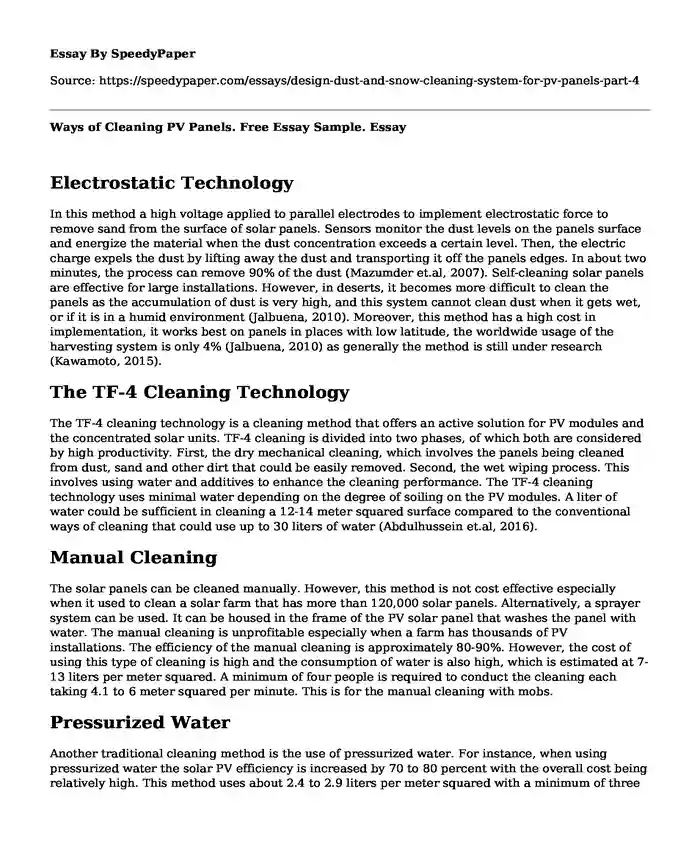
| Type of paper: | Essay |
| Categories: | Engineering Ecology Technology Energy |
| Pages: | 3 |
| Wordcount: | 677 words |
Electrostatic Technology
In this method a high voltage applied to parallel electrodes to implement electrostatic force to remove sand from the surface of solar panels. Sensors monitor the dust levels on the panels surface and energize the material when the dust concentration exceeds a certain level. Then, the electric charge expels the dust by lifting away the dust and transporting it off the panels edges. In about two minutes, the process can remove 90% of the dust (Mazumder et.al, 2007). Self-cleaning solar panels are effective for large installations. However, in deserts, it becomes more difficult to clean the panels as the accumulation of dust is very high, and this system cannot clean dust when it gets wet, or if it is in a humid environment (Jalbuena, 2010). Moreover, this method has a high cost in implementation, it works best on panels in places with low latitude, the worldwide usage of the harvesting system is only 4% (Jalbuena, 2010) as generally the method is still under research (Kawamoto, 2015).
The TF-4 Cleaning Technology
The TF-4 cleaning technology is a cleaning method that offers an active solution for PV modules and the concentrated solar units. TF-4 cleaning is divided into two phases, of which both are considered by high productivity. First, the dry mechanical cleaning, which involves the panels being cleaned from dust, sand and other dirt that could be easily removed. Second, the wet wiping process. This involves using water and additives to enhance the cleaning performance. The TF-4 cleaning technology uses minimal water depending on the degree of soiling on the PV modules. A liter of water could be sufficient in cleaning a 12-14 meter squared surface compared to the conventional ways of cleaning that could use up to 30 liters of water (Abdulhussein et.al, 2016).
Manual Cleaning
The solar panels can be cleaned manually. However, this method is not cost effective especially when it used to clean a solar farm that has more than 120,000 solar panels. Alternatively, a sprayer system can be used. It can be housed in the frame of the PV solar panel that washes the panel with water. The manual cleaning is unprofitable especially when a farm has thousands of PV installations. The efficiency of the manual cleaning is approximately 80-90%. However, the cost of using this type of cleaning is high and the consumption of water is also high, which is estimated at 7- 13 liters per meter squared. A minimum of four people is required to conduct the cleaning each taking 4.1 to 6 meter squared per minute. This is for the manual cleaning with mobs.
Pressurized Water
Another traditional cleaning method is the use of pressurized water. For instance, when using pressurized water the solar PV efficiency is increased by 70 to 80 percent with the overall cost being relatively high. This method uses about 2.4 to 2.9 liters per meter squared with a minimum of three people cleaning at a rate of 18-20 meter squared per minute (Schneider et.al, 2015)
Water departures at high speed from a number of nozzles at the top of the panel. The pressurized water hits the panel cleaning the sand and dust from its surface (Moharramet.al, 2013).
Compressed Air
According to Dorman, 2014, this method involves shifting dust from one place to another. Normally, the method is energy intensive and has indirect negative impacts on the personal property. Another demerit is that it involves challenging mobilization. In an experiment using the compressed air cleaning method it was noted that the efficiency of the cleaning method was less than 70% with a relatively low cost per meter squared. The advantage of using this method is that it does not use water and the man power needed is medium. Around 3 people are required to clean within a radius of 15 to 20 meter squared per minute.
Steam Cleaning
This method when using steam to clean the solar PV panels, the efficiency is about 90%. The cost per KWh is low and the water consumption is estimated at 0.5-0.63 liters per meter squared. The man power needs is very low with one person required to clean 22 to 27 meter squared per minute (Al-Ghannam, 2012).
Cite this page
Ways of Cleaning PV Panels. Free Essay Sample.. (2017, Sep 09). Retrieved from https://speedypaper.com/essays/design-dust-and-snow-cleaning-system-for-pv-panels-part-4
Request Removal
If you are the original author of this essay and no longer wish to have it published on the SpeedyPaper website, please click below to request its removal:
- Free Essay on Yahoo Human Resources
- Essay Example on Leadership in Organizations
- Free Essay Example: Internet for Young People
- Is Feminism Justified? Essay Example
- Essay Example Analyzing Conventionalist Ethical Relativism
- Physical, Psychological and Sexual Abuse - Free Essay Sample
- Paper Example. Acute Otitis Media Infection
Popular categories




